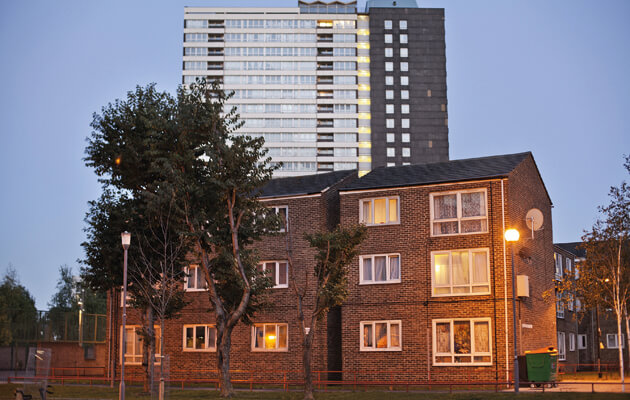|
|
||
|
A new London vernacular has emerged over the past five years – but is the moral laziness it represents an omen for the city’s future, asks Leo Hollis? Getting off the train at Stratford, you are offered two very distinctive versions of the newly regenerated neighbourhood. Head southwards, take the bridge that crosses over the tracks, and within five minutes you reach the Carpenters Estate, a collection of council houses organised around three 1967 tower blocks. The estate has been earmarked for demolition and today looks the worse for wear. The streets have been decanted of people in order to make room for new housing. The locals have not gone without a fight, arguing that the fabric of the traditional streets of brick houses is sound and that this place can still be home to a thriving community. Return to the station and make one’s way through the bustle of Westfield towards the new housing areas within the Queen Elizabeth Olympic Park: here one finds a different story. This is the fastest growing housing development in the capital. By 2030, there will be homes for over 10,000 people. Each area has been renamed to infuse this once industrial ground with a sense of bucolic idyll: East Village, Chobham Manor, Sweetwater, Pudding Mill. Much attention has been given over to the fabric of the new housing, which, according to the marketing material, boasts “contemporary homes taking lessons from London’s traditional Georgian and Victorian squares and terraces, looking out over parklands and waterways”. Both places – the discarded Carpenters Estate and the new Olympolis developments – are expressions of London vernacular. While one is criticised for being unfit for purpose, the other is proposed as the answer to the modern Londoner’s desires for sophisticated design, public planning and convenient urban living. Why are they treated so differently? In the recent pamphlet from Urban Design London entitled A New London Housing Vernacular, authors David Birkbeck and Julian Hart identify a change that has occurred in the last five years, wiping colour and variety from the faces of the capital’s recent developments. There are subtle alterations and features: more homes on the ground floor with their own front doors, as well as less shared access space for residents. The elevations are predominantly faced with brickwork, punched with featureless, recessed windows. If there are balconies, they are also recessed and in brick. There is often semi-public private space in front of the building, but designed as shrub beds rather than a garden or play area: green, planted non-space. One of the principles of this new vernacular was a return to the Georgian syntax of the London street. This was partly dictated by City Hall. While Ken Livingstone encouraged increased density and large developments as mayor, Boris Johnson was concerned that the drive for numbers reduced quality. This culminated in the 2009 London Housing Design Guide, which coincided with a housing-based credit crunch that swiftly doubled-down into the Great Recession. The guide emphasised the honest typography of the traditional 19th-century street, replacing colour-splash facades, barcodes and wave-feature roofs with a restrained, almost blank face, ordered fenestration and a parapet that was often topping a recessed penthouse. Was this a return to more simple or honest times, with new developments taking on the utilitarian signature of interwar council housing? Perhaps, but these were buildings created by developers, and as a result the London vernacular is an expression of their reading of the market. What are they telling us about the future of the city? Most clear is the importance of sales, of design and construction, and of the reduction of risk. These new blocks are easier, and often cheaper, to build. This is an important factor as land prices continue to soar. These are buildings that offer satisfaction on the computer screen, the brickwork picked out in pixels, as well as in the marketing brochure. From the outside, it is impossible to say how the interior is organised – the size of the units and the number of bedrooms – thus avoiding the embarrassments of luxury, in contrast to the flashy non-dom investment empty towers elsewhere in the city. Some of the flats might even be affordable housing, but you can’t tell from the outside. The new London vernacular is dictated by the developers to mitigate risk, rather than offer “hard-working Londoners” the home of their dreams. Rather than appeal to the homely desires of the buyer, it prioritises the developer’s ability to shift product without friction. And this gets to the heart of the paradox of the neoliberal city. This doctrine suggests that the London of the 21st century is being redeveloped according to principles that offer the consumer infinite choice, but in fact we are offered acres of the same. As political economist William Davies noted when he walked around Stratford in 2014, it is not arbitrary that while the Carpenters Estate is deigned “inefficient”, its modern incarnation – new, regenerated East Village – fills the windows of the estate agents, marked out as a good investment. This is not laziness in the normal sense of the word. There is nothing lazy about the developer’s pursuit of a design that mitigates risk in pursuit of a 20 per cent return for their investors. But their goals are no longer aligned with those who have to live there. Rather, the developers display a sloth that Dante revealed in the fourth terrace of Purgatory: the moral laziness found in the failure of will or courage to pursue virtue. Rather than “city-making” – the idea of rebuilding the city, the New Jerusalem that inspired the Carpenters Estate, however flawed and unachieved – we are being sold the small beer of place-making, a short-term strategy with narrow horizons. London deserves more than that. |
Words Leo Hollis |
|
|
||

















